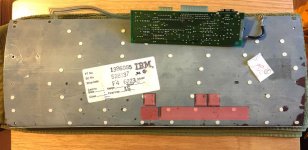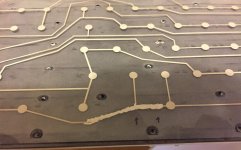allCAPPS
Experienced Member
Hello, everyone. I'm posting to get a second opinion on fixing a Model M which has a few keys that aren't working. Any help would be greatly appreciated.
This photo shows where the malfunctioning keys are in relation to the backplate. Curiously, the rivets appear to be okay near where the malfunctioning keys are. But there are broken rivets where perfectly functional keys are. Go figure.

You may notice some oxidation on the right side of the image, and I strongly suspect that might have something to do with the problem. From what I understand, the primary purpose of a bolt mod is the re-squeeze the layers together, but I suspect a full disassembly and bolt mod may be necessary just to get to any corrosion between the layers.
So before I potentially go off on a joy-ride bolt mod, is there anything I'm overlooking? Am I on the right track with a bolt mod?
Specifically:
Thanks in advance for the help!
This photo shows where the malfunctioning keys are in relation to the backplate. Curiously, the rivets appear to be okay near where the malfunctioning keys are. But there are broken rivets where perfectly functional keys are. Go figure.

You may notice some oxidation on the right side of the image, and I strongly suspect that might have something to do with the problem. From what I understand, the primary purpose of a bolt mod is the re-squeeze the layers together, but I suspect a full disassembly and bolt mod may be necessary just to get to any corrosion between the layers.
So before I potentially go off on a joy-ride bolt mod, is there anything I'm overlooking? Am I on the right track with a bolt mod?
Specifically:
- How successful might a bolt mod be?
- If I were to do a bolt mod, what should be done once inside (other than a thorough cleaning of the contacts and testing for continuity)?
- I'm out of Deoxit, but would be worth squirting some in the switch barrels first?
- Is there anything I'm not thinking of here?
Thanks in advance for the help!


